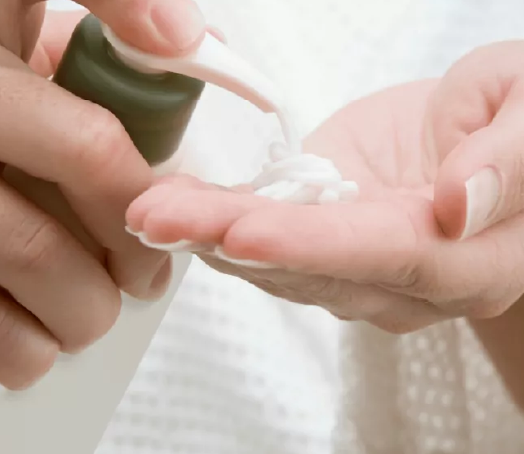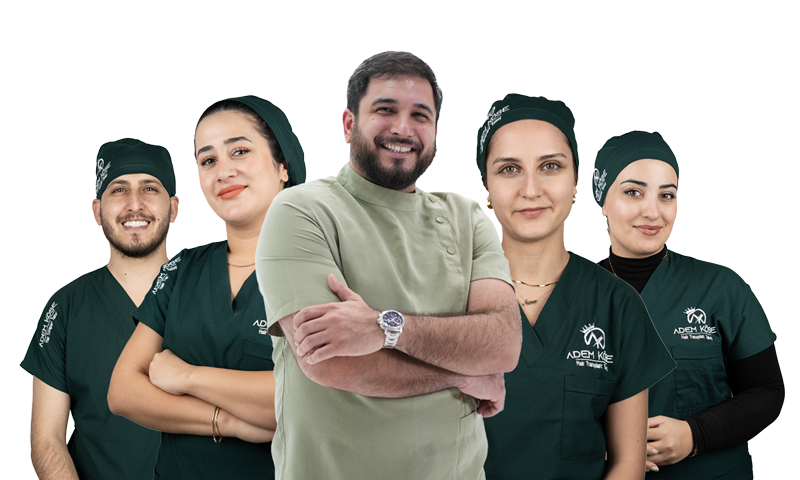Adem Köse Hair Transplant Clinic
Hair Transplant Turkey – Istanbul
Experience the best Afro Hair Transplant with the world’s leading clinic. Expert surgeons in Turkey deliver natural, life-changing results at affordablices!
Free Doctor Hair Analysis
Get your hair analysis easily in just 4 steps! Fill out the form and our experts will contact you.
Expert Clinic for Hair Transplantation in Turkey
Millions of people all over the world are impacted by a common condition: hair loss, which affects confidence and body image. Baldness or thinning hair individuals find hair transplant Turkey is the permanent, natural, and affordable solution to this problem.
Turkey has become one of the best destinations in the world for hair replacement surgery, and its capital city, Istanbul, is known for state-of-the-art technology, experienced surgeons, and a high success rate. Hair transplant and restoration techniques such as FUE, DHI, and Sapphire FUE are performed by experts at the Adem Kose Hair Transplant Clinic, ensuring the best possible results.
If you’re in the process of considering hair surgery in Turkey, this extensive guide will address everything from techniques, costs, and patient testimonials, as well as recovery timelines and aftercare.
Turkey Hair Transplant – Why You Should Get it in Turkey?
Turkey, which is a popular destination for hair transplant, and the reason for that is the high-quality, affordable cost, and latest technologies in Turkey hair transplant procedures for international patients in the last decade. Turkey hair replacement, thousands of international patients every month, all come to Istanbul.
Cost Benefits – Hair Restoration is Cheap but High-Quality
The very first reason why the hair implants in Turkey are preferred is related to the cost. Patients can pay up to 70% less than in clinics in the UK, USA, and Europe and still get the best quality of medical treatment.
Hair Transplant Surgery Cost Comparison
| Country | Average Cost (3,000 Grafts) |
|---|---|
 Turkey |
$2,000 – $4,000 (VIP Package incl.) |
 UK |
£6,000 – £12,000 |
 USA |
$8,000 – $15,000 |
 Germany |
€5,000 – €10,000 |
In this sense, our hair transplant Turkey packages are all inclusive:
- Personalized Consultation
- Procedure of Hair Transplant with Therapy
- Luxury 5-Star Hotel Stay (3-5 Nights)
- VIP Airport Transfers
- Medications & Aftercare Kit (Post-Op)
Highly Qualified Surgeons & Internationally Recognized Clinical Facilities
Turkey hair transplantation clinics around the world are known for their high medical standards and state-of-the-art facilities. Adem Kose Our clinic provides:
- Hair Transplant Surgeons Certified All Over The World
- Cutting Edge Equipment & Techniques
- Key Services with Strict Hygiene & Safety Standards
- Personalized treatment plans
Advanced Hair Transplant Methods & High Success Rates
We conduct the best hair loss surgery in Turkey; natural-looking hairlines, high graft survival, and fast recovery are guaranteed by Adem Kose Hair Transplant Clinic. If you require hair plugs in Turkey to conceal bald spots, or you need full hair replacement in Turkey, our specialized techniques guarantee long-term outcomes.
Hair Transplant Techniques We Offer
There are many hair transplant surgery Turkey methods, each providing specific advantages. There are three methods of hair plantation in Turkey practiced in our clinic.
Follicular Unit Extraction (FUE) Hair Transplant
DHI Hair Transplant (Direct Hair Implantation)
Sapphire FUE - The most progressive
THOSE WHO CHANGED THEIR LIVES
Success Stories We Proudly Share
Each hair transplant journey represents a new beginning and a life-changing transformation. In our clinic, we have performed thousands of successful operations by gaining the trust of our patients from all over the world.

Ahmet Kul
Went to Adem Kose and was very impressed with their professionalism and expertise. They made everything as easy as possible and were very helpful. Thank you!
FUE
Germany
18 Month
2333 Greft

Stefhan Guttier
Went to Adem Kose and was very impressed with their professionalism and expertise. They made everything as easy as possible and were very helpful. Thank you!
DHI
Germany
18 Month
2333 Greft

Mehmet Keskin
Went to Adem Kose and was very impressed with their professionalism and expertise. They made everything as easy as possible and were very helpful. Thank you!
FUE
Germany
18 Month
2333 Greft

Arnold Buster
Went to Adem Kose and was very impressed with their professionalism and expertise. They made everything as easy as possible and were very helpful. Thank you!
DHI
Germany
18 Month
2333 Greft

Muhaya Danguk
Went to Adem Kose and was very impressed with their professionalism and expertise. They made everything as easy as possible and were very helpful. Thank you!
DHI
Germany
18 Month
2333 Greft
Stages of Hair Transplant
How Do You Obtain Our Assistance?

Step 01
Send us your photos, We plan your operation
Start envisioning your own transformation today and send us your photo. We meticulously plan every aspect of your operation, ensuring a seamless and successful procedure.

Step 02
Hair transplant operation, Postoperative Care & Hair Wash
Transform your look and confidence with a hair transplant operation. Ensure optimal healing and hair growth with our comprehensive postoperative care and hair wash services.

Step 03
Follow up after you return to your country
Stay connected with our personalized follow-up care after you return to your country.
OUR CLINIC & HOTEL
Scientific Hair Transplant Clinic






13+ Years of experience
21K+ Operations
17+ Countries
WHY ADEM KOSE?
Elevating Confidence, One Strand at a Time
Discover the expertise and artistry of Adem Köse Hair Transplant, where every procedure is a testament to precision, innovation, and natural-looking results. With a commitment to excellence and a passion for restoring confidence, Adem Köse Hair Transplant Clinic is your trusted partner in achieving your hair restoration goals. Experience the difference with our personalized approach and superior care.

ADEM KOSE
We love sharing our incredible results.
*The ‘European Awards in Medicine 21st Century’, one of Europe’s most important organizations in the field of medicine were conferred.
All-Inclusive Package
Europe's Best Hair Transplant Surgeon
Supported by 5+ Skilled Doctors
High Medical Standards
Adem Köse Clinic Doctors
At Adem Köse Hair Center Clinic, our doctors specialize in state-of-the-art hair restoration. We are committed to delivering natural results with personalized medical care.



Send Photos on WhatsApp!
Customized Hair Analysis Free of Charge
It’s easy to get in touch with us! Share photos of your hair via WhatsApp and our team of experts will examine the situation and prepare the most suitable solutions for you. This process is completely free of charge and completely personalized for you. Let’s take the first step together for a new beginning!

Frequently ask question
Everything you need to know right here at your fingertips. Ask questions, browse around for answers, or submit your feature requests.
Full results are typically visible within 6 to 12 months after the procedure.
Hair transplantation is an effective solution for many individuals experiencing hair loss, but not everyone is an ideal candidate. Here’s a detailed look at who can benefit most from this procedure: 1. Individuals with Pattern Baldness Male Pattern Baldness: Men with receding hairlines, thinning crowns, or overall hair loss. Female Pattern Baldness: Women with thinning hair or widening part lines. 2. Those with Sufficient Donor Hair A good candidate must have enough healthy hair follicles in the donor area (typically the back or sides of the scalp) to transplant to the thinning or balding areas. 3. People in Good Overall Health Candidates should be in good physical and mental health, as the procedure requires minor surgery and a recovery period. 4. Individuals with Realistic Expectations Understanding that hair transplantation provides natural-looking results but may not restore the exact hair density of youth is crucial. 5. Those with Stable Hair Loss Hair loss should be stable or slowing down. Transplanting hair during active hair loss may require additional procedures in the future. 6. People Who Have Tried Other Treatments Candidates who have tried medications or non-surgical treatments without success may find hair transplantation to be the next best option. 7. Age Considerations While there’s no strict age limit, younger patients (under 25) may need to wait until their hair loss pattern stabilizes. Older patients with sufficient donor hair can also benefit. Who May Not Be a Good Candidate? Individuals with widespread hair loss and insufficient donor hair. Those with certain medical conditions (e.g., uncontrolled diabetes, bleeding disorders). People with unrealistic expectations about the results.
Common techniques include FUE (Follicular Unit Extraction) and FUT (Follicular Unit Transplantation).
Avoid smoking, alcohol, and certain medications before the procedure as advised by your surgeon.
Once the transplanted hair has fully healed, you can cut, style, and dye it as usual.
Yes, because the hair is taken from your own scalp, it matches your natural hair texture and color.
Recovery time varies, but most patients can resume normal activities within a week.
The time it takes to return to work after a hair transplant depends on the technique used, the extent of the procedure, and your job requirements. Here’s a detailed guide to help you plan your recovery: 1. Immediate Post-Procedure (First 2-3 Days) Rest is Essential: The first 48-72 hours are critical for healing. Avoid any strenuous activities and focus on resting. You may experience mild swelling, redness, or scabbing in the treated areas. Sedentary Jobs: If your job is not physically demanding (e.g., office work), you may return to work within 2-3 days. Wearing a loose hat or bandana can help conceal any visible signs of the procedure. 2. First Week After the Procedure Physical Jobs: If your job involves physical labor, heavy lifting, or exposure to dust and dirt, it’s recommended to wait 7-10 days before returning. This allows the grafts to settle and reduces the risk of complications. Swelling and Scabbing: Swelling and scabbing typically subside within the first week. Follow your surgeon’s aftercare instructions to speed up healing. 3. Long-Term Recovery Visible Healing: Most patients see significant healing within 10-14 days, and any redness or scabbing will fade. By this time, you can resume most normal activities, including work, without restrictions. Hair Growth Timeline: Transplanted hair may shed within 2-4 weeks, but this is normal. New hair growth typically begins after 3-4 months, with full results visible in 9-12 months. Tips for a Smooth Return to Work: Follow your surgeon’s aftercare instructions carefully. Avoid touching, scratching, or rubbing the treated areas. Protect your scalp from direct sunlight and wear a hat if necessary. Stay hydrated and maintain a healthy diet to promote healing.
The donor area is typically the back or sides of the scalp where hair growth is stable.
Hair transplantation is a surgical procedure designed to restore hair in areas where hair loss or thinning has occurred. It involves transferring healthy hair follicles, typically from the back or sides of the scalp (donor area), to the balding or thinning areas (recipient area). This procedure is a permanent solution for hair loss and is widely used to treat conditions like male pattern baldness, receding hairlines, and thinning hair in both men and women. How Does Hair Transplantation Work? The two most common techniques used in hair transplantation are: FUE (Follicular Unit Extraction): Individual hair follicles are extracted directly from the donor area and transplanted to the recipient area. This method leaves minimal scarring and has a faster recovery time. FUT (Follicular Unit Transplantation): A strip of skin containing hair follicles is removed from the donor area, and the follicles are then transplanted to the recipient area. This method is ideal for patients requiring a larger number of grafts. Who is a Good Candidate for Hair Transplantation? Individuals with sufficient donor hair for transplantation. Those experiencing pattern baldness or thinning hair. People in good overall health with realistic expectations. Individuals who have tried other treatments (e.g., medications) without success. Benefits of Hair Transplantation: Permanent, natural-looking results. Boosts self-confidence and improves appearance. Minimal downtime and long-term satisfaction. If you’re considering hair transplantation, consult with a qualified specialist to determine the best approach for your unique needs.
What did our patients say about us?
Hear from our patients about their real experiences and the care they received throughout their journey.
It is a team that is very interested, friendly and does its job very well and meticulously. I have not been able to trust and go anywhere for years and I am glad that I came here. Entrust yourself to Adem Köseye, sit back, you will not regret it, come with your eyes closed.
Dear Dr. Adem, I would like to extend my heartfelt thanks for the professionalism, care, and attention you showed throughout my hair transplant process. Your support and warm demeanor at every stage made this journey much easier and more comfortable for me.
Thanks to your skill and dedication, I am now experiencing the joy of a fresh start. Your passion for your work and the value you place on your patients are truly admirable. I am deeply grateful to you and your team.
Wishing you continued success. Thank you once again for everything.
Sincerely, Gürsoy Ulusoy.
I’ve been undergoing hair loss treatment for the past three months. I would like to thank Mr. Kerem and Dr. Adem for their continuous care and attention throughout the entire process. I’m very happy — my hair loss has stopped, and my hair has become much fuller. I’m truly grateful. 🙏🙏🙏
There are so many hair transplant clinics out there that it can be hard to decide which one is truly the best. I went to Dr. Adem based on a recommendation, and it was my first time getting a hair transplant.
The staff were incredibly friendly, and their level of care and attention was outstanding. The materials used were of top quality, and everyone was clearly an expert in their field.
It’s truly a place you can go without hesitation — I highly recommend it.
Many thanks to Dr. Adem and his team!
From start to finish, I was welcomed in an exceptional way, with special attention given to making me feel comfortable and safe. The facility is not only clean and modern but also extremely well-organized, which immediately inspires confidence.
The team is warm, attentive, and highly professional. Their expertise is evident, and they take the time to patiently and clearly answer every question. You can truly feel that they are masters of their craft with a great deal of experience.
Every stage of the hair transplant process — before, during, and after the procedure — was thoroughly explained with attentive support. The follow-up care is meticulous and personalized, ensuring full support until the final result.
I’m extremely satisfied with my experience and would recommend this clinic without hesitation!